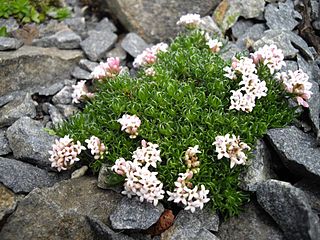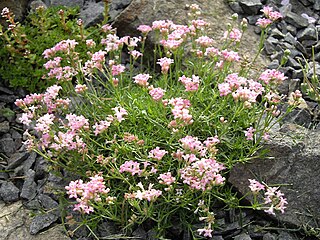
Chamaecytisus is a genus of flowering plants in the legume family, Fabaceae. It includes 43 species which range from the Canary Islands and Morocco through mainland Europe to western Siberia, Kazakhstan, the Caucasus, Anatolia, and the eastern Mediterranean. It belongs to the subfamily Faboideae. It may be a synonym of Cytisus.

Juncus is a genus of monocotyledonous flowering plants, commonly known as rushes. It is the largest genus in the family Juncaceae, containing around 300 species.

Luzula is a genus of flowering plants in the rush family Juncaceae. The genus has a cosmopolitan distribution, with species occurring throughout the world, especially in temperate regions, the Arctic, and higher elevation areas in the tropics. Plants of the genus are known commonly as wood-rush, wood rush, or woodrush. Possible origins of the genus name include the Italian lucciola or the Latin luzulae or luxulae, from lux ("light"), inspired by the way the plants sparkle when wet with dew. Another etymology sometimes given is that it does derive from lucciola but that this meant a mid-summer field, or from the Latin luculus, meaning a small place; the same source also states that this name was applied by Luigi Anguillara in 1561.

Asperula, commonly known as woodruff, is a genus of flowering plants in the family Rubiaceae. It contains 194 species and has a wide distribution area from Europe, northern Africa, temperate and subtropical Asia to Australasia.

Cynanchica, commonly known as woodruff, is a genus of flowering plants in the family Rubiaceae. It contains 73 species and has a wide distribution area from Europe, northern Africa, the Middle East and central Asia. The genus was erected in 2020 to accommodate species split from the genus Asperula.

Carex capillaris, the hair-like sedge, is a species of sedge found in North America and northern Eurasia including Greenland.

Cynanchica aristata, commonly known as woodruff, is a deciduous species of perennial groundcover, and a flowering plant in the family Rubiaceae. It is native to Morocco, Libya, Algeria, Tunisia, Azerbaijan, Georgia, Armenia, Greece, Bulgaria, Albania, Serbia, North Macedonia, Croatia, Italy, Austria, Switzerland, France, Spain, and Portugal.

Cynanchica gussonei, also known as alpine woodruff, is a deciduous species of perennial groundcover, and a flowering plant in the family Rubiaceae. It was first described in 1831 and is endemic to Sicily.

Cynanchica lilaciflora is a species of flowering plant in the family Rubiaceae.
Carex altaica is a species of sedge and is native to Mongolia, Siberia, and northwestern China.

Juncus inflexus, the hard rush, is a species of flowering plant in the family Juncaceae, native to Europe, Asia and Africa, and introduced in Sri Lanka, Java, Île Amsterdam and Île Saint-Paul, Victoria in Australia, New Zealand, Uruguay, and eastern North America. It is a glycophyte (non-halophyte).

Juncus alpinoarticulatus, called the northern green rush and the alpine rush, is a species of flowering plant in the genus Juncus, with a circumboreal distribution. It prefers wet sandy soils, peat bogs, acidic fens, and ditches.
Carex mackenziei is a species of flowering plant belonging to the family Cyperaceae.
Cynanchica abbreviata, commonly known as woodruff, is a species of flowering plant in the family Rubiaceae that is endemic to Naxos and Amorgos in Greece. It was first formally described in 1901 by Eugen von Halácsy who gave it the name Asperula lutea var. abbreviata in Conspectus Florae Graecae. In 1943, Karl Heinz Rechinger raised the variety to species status as Asperula abbreviata in Denkschriften der Kaiserlichen Akademie der Wissenschaften / Mathematisch-Naturwissenschaftliche Classe. In 2020, it was reclassified into the newly erected genus Cynanchica.
Cynanchica accrescens, commonly known as woodruff, is a deciduous species of perennial groundcover, and a flowering plant in the family Rubiaceae. It is endemic to Transcaucasus and was first named by Klokov.
Asperula acuminata is a deciduous species of perennial groundcover, and a flowering plant in the family Rubiaceae, known as Woodruff, and is endemic to NE. New South Wales of Australia, and was first named by I.Thomps.
Cynanchica affinis is a deciduous species of perennial groundcover, and a flowering plant in the family Rubiaceae. It is endemic to north-eastern Turkey and the Transcaucasus, and was first named by Boiss. & A.Huet.

Carex adelostoma is a tussock-forming species of perennial sedge in the family Cyperaceae. It is native to the subarctic areas, including Scandinavia, Russia, Canada, and Alaska. A common name is circumpolar sedge.
Carex ulobasis, also known as montane sedge, is a tussock-forming species of perennial sedge in the family Cyperaceae. It is native to parts of eastern Russia in the north to Korea in the south.












